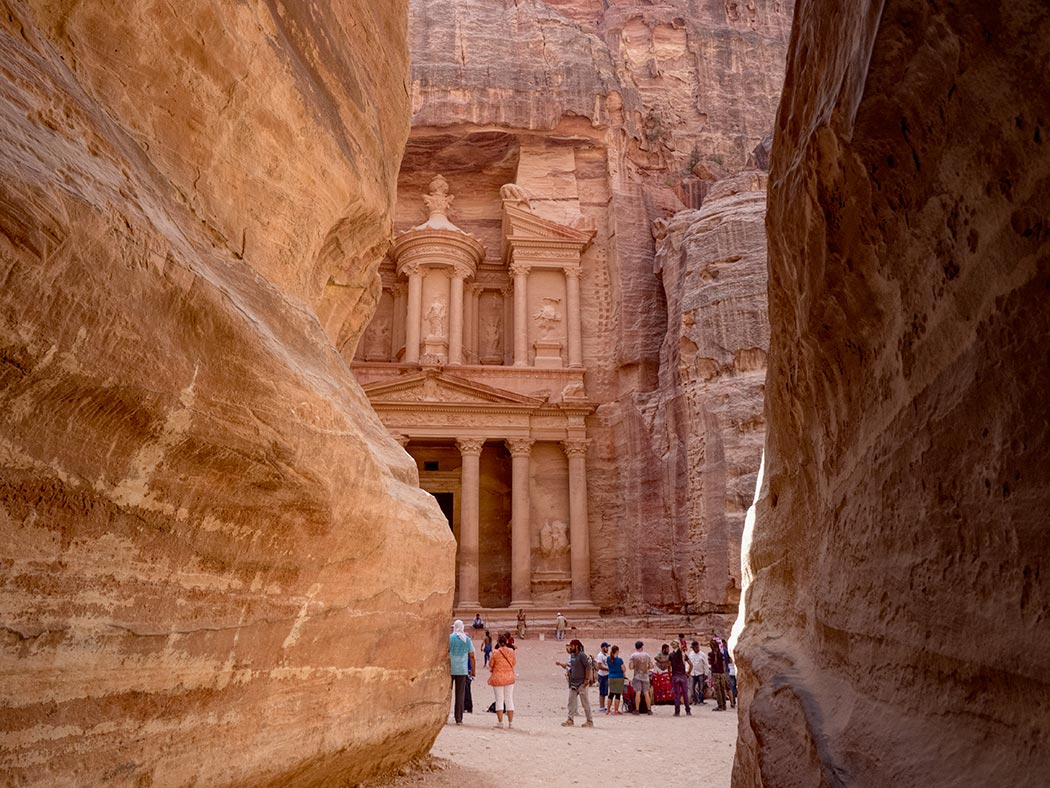The Treasury at Petra, one of the most magnificent archaeological sites in the world, ranks high on any list of the best places to visit in Jordan. The structure was carved from solid rock by the Nabataeans, who are thought to have been an ancient Arabic tribe. Very little is known about the Nabataeans. It is believed that they began as a nomadic tribe, wandering the northern Arabian Peninsula in search of water and pastures for their herds of animals. Over time they settled in the area now known as Petra, which was situated at the crossroads of caravan routes that linked China, India, and South Arabia with the Mediterranean world. Capitalizing on their advantageous location and intimate knowledge of the Arabian geography, the Nabataeans became master merchants and traders in the first centuries BC and AD.
Petra may have been the most important trading center of all. Located at the end of a three-quarter-mile long slot canyon known as the Siq, the entrance to the city was wide enough to allow a caravan of camels to pass but narrow enough to be easily guarded and defended. Traders who were allowed through must have been stunned when they rounded the final curve in the serpentine corridor and were confronted with The Treasury. The Nabataeans were eventually conquered by the Roman Empire and their culture gradually disappeared. Archaeologists theorize that they assimilated into Roman culture and lost their separate identity. The Nabataean culture may have disappeared, but their shining red city in the desert remains in all its glory. An early morning walk through The Siq virtually guarantees seeing the Treasury at Petra without crowds, but the true spectacle happens in late afternoon, when the sinking sun turns the rocks and structures fiery red.


Great article. I’ve always struggled with the belief that the carving style wasn’t Roman, as it seems to represent. As the Nabataeans were nomadic Arabs, the detail in the gable carvings seems too (dare I say) “civilized”. Do you know if the Romans augmented the fascia at all after occupation?
I don’t know Andrew, but that’s an intriguing thought
This sounds like an amazing site. I’m so glad to be on your emailing list. I’m getting ideas for future travel…
Thank you Irene – I appreciate your very kind words and am glad to be helpful with your travel plans!
Barbara, did you join a tour from Amman or went to those sites independently?If you were on a tour, do you recommend them? I’ll be in Egypt in May and am thinking of going to Jordan from there.
Hi Wagner: My next article, which should be published within the hour, will provide you all the details you need. If there’s anything else, just email me or leave another comment.
Nice.. thanks for sharing.. loved pictures
Barbara: Your photos and stories are so inspiring. I really appreciate how you give us a bit of the history/context at every turn! I also love your writing about the surprises and mis-adventures. You help us armchair travelers feel like we are there.
Thank you so much Nancy – saying that my words make you feel like you were there is just about the highest compliment you can pay a writer. You made my day!
Outstanding photography thank you for sharing
Thanks so much Julia 🙂
Amazing pics
There is a sister site to Petra in Saudi Arabia called Madain Selah. Also built by the Nebatians , similar in architecture, it is bigger and more beautiful.
How I would love to visit Saudi Arabia? But as a solo female, I don;t think it’s possible, at least not yet.